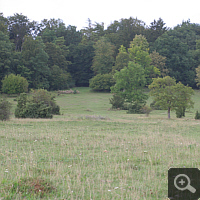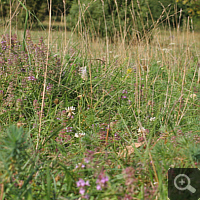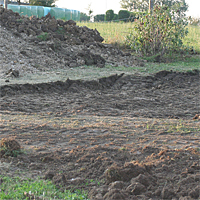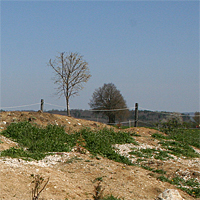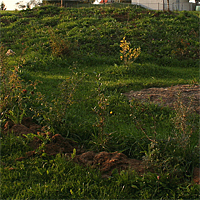Juniper Heath
Overview
Juniper heaths are biotopes which landscape is characterized by the Common Juniper (Juniperus communis). Mostly, the biotopes are covered with semi-dry grassland or xeric grassland. Due to continuous grazing with sheep evolved, mostly on sunny exposed hillsides on limestone, Baden-Wuerttemberg semi-dry to xeric grassland, on which the light-hungry juniper was able to proliferate. Until today, these biotopes are for the Swabian Alps, on which fringe I am grown up, dominating the landscape.
Almost all juniper heaths of the Southern German region present as association of plants a Mesobromion (Gentiano-Koelerietum). Defining grass species are the Tor-grass (Brachypodium pinnatum), the Sheep Fescue (Festuca ovina), the Crested Dog’s-tail (Cynosurus cristatus) and the Prairie June Grass (Koeleria pyramidata). Those grasses is in common the short-stalky and partly wildrye-like growth. As further vegetation on juniper heaths can you find species, which with get along with the nutrient-poor and dry-warm conditions on the one hand and with the high grazing pressure on the other hand. Therefore juniper heaths are rather species-poor biotopes.
Following adjustment mechanisms to the grazing strain were developed:
- bitter or pungent flavour as well as poisonous ingredients
- mechanical defence mechanisms (prickles, thorns or needles)
- rosette-like growth and propagation by hypogeal stolons
To the group of plants with bitter ingredients belong the gentians, like the Spring Gentian (Gentiana verna) with beautiful dark blue blossoms or the Fringed Gentian (Gentianella ciliata) and the Chiltern Gentian {Gentianella germanica). Because of essential oils taste also the Broad-leaved Thyme (Thymus pulegioides) and the Oregano (Origanum vulgare) bitter. Due to poisons hedge the attractive Common Pasque Flower (Pulsatilla vulgaris), the conspicuous White Swallow-wort (Vincetoxicum officinale), the Bear’s Foot (Helleborus foetidus) and the Cypress Spurge (Euphorbia cyparissias).
The stinging needles of the Common Juniper (Juniperus communis) are also mechanical protection as the prickles and thorns of the European Barberry (Berberis vulgaris), the Common Buckthorn (Rhamnus catharticus), the Blackthorn (Prunus spinosa), the Hawthorns (Crataegus spec.) and several wild rose species like the Dog Rose (Rosa carina). All the same hedge mechanically the Spiny Restharrow (Ononis spinosa) and several thistle species, like the beautiful Silberdistel (Carlina acaulis), the Carline Thistle (Carlina vulgaris), the Dwarf Thistle (Cirsium acaule) and the Woolly Thistle (Cirsium eriophorum).
Due to leaves, sitting close to the ground, or subterranean storage organs minimise other species feeding damage or sprout quickly anew. To this group belong several Plantain species (Plantago spec.), the Salad Burnet (Sanguisorba minor), the Mouse-ear Hawkweed (Hieracium pilosella), the Mountain Germander (Teucrium montanum) and the Stoloniferous Pussytoes (Antennaria dioica). Furthermore some already ahead mentioned species and many orchid species. Here were name first and foremost the Bee Orchids (Ophrys) and the exceptionally for the grazing well adapted and extremely rare Autumn Lady’s-Dresses (Spiranthes spiralis).
Project
Explanation of construction and schematic representation
 In summer 2009 I have started with construction of a juniper heath. For this purpose I have raised the spoil of the raised bog bed to a circa 15 metres long and 10 metres broad south-exposed hill. First the humus-rich parts, then the humus-poor, loamy spoil parts. In winter the hill has firm about circa 30 cm, so that it now, at the highest point, towers the surrounding niveau about circa 2 metres. Slope of the hill is circa 10°. As typical deciduous wood I have planted a great European Cornel on the hill, in addition several specimens of the Common Juniper. Beyond that I have planted a mixed wild hedge at northern slope.
In summer 2009 I have started with construction of a juniper heath. For this purpose I have raised the spoil of the raised bog bed to a circa 15 metres long and 10 metres broad south-exposed hill. First the humus-rich parts, then the humus-poor, loamy spoil parts. In winter the hill has firm about circa 30 cm, so that it now, at the highest point, towers the surrounding niveau about circa 2 metres. Slope of the hill is circa 10°. As typical deciduous wood I have planted a great European Cornel on the hill, in addition several specimens of the Common Juniper. Beyond that I have planted a mixed wild hedge at northern slope.
Progress
Although I have still in autumn 2009 sown typical grasses of juniper heaths (collected on areas that are not protected!), this spring appeared especially typical ruderal species. To put it more markedly: The hill was a pure weeds hill! Now is the time for exercising patience and taking over the task of sheep. This means to mow consequently the hill for years and to clear away grass clippings. As a result of this I will achieve in the long term a distinct emaciation of the area, so that I can attempt in some years the establishment of typical charakter plants.
The European Cornel have showed so far that problems, which larger woody plants show in general on raised surfaces – namely permanent water shortage. It takes years before a raised surface shows a running capillary action, thus transports water from deeper layers into higher in sufficient measure. In addition rainwater can due to still poor consolidation of soil substantially faster seep away in deeper layers. There is nothing for it but to water regularly.

